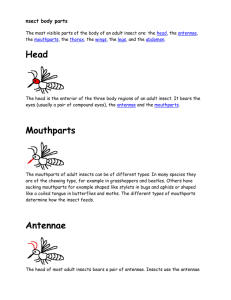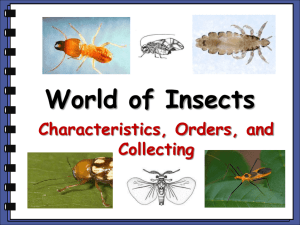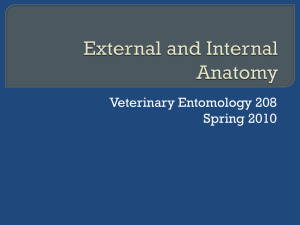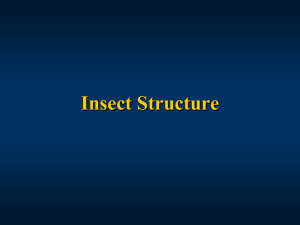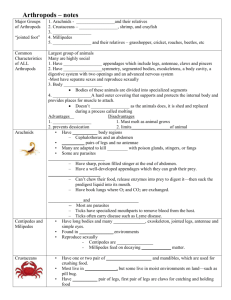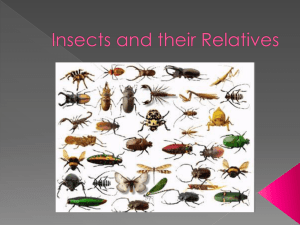Insect Notes
advertisement
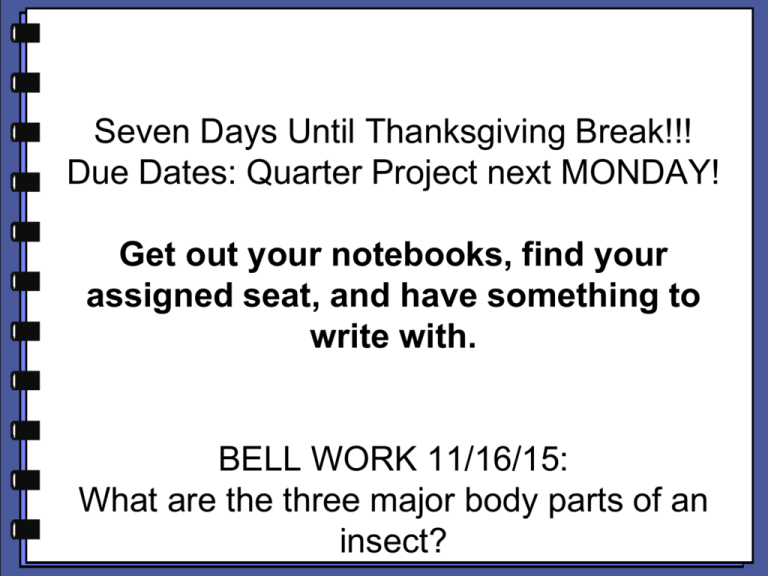
Seven Days Until Thanksgiving Break!!! Due Dates: Quarter Project next MONDAY! Get out your notebooks, find your assigned seat, and have something to write with. BELL WORK 11/16/15: What are the three major body parts of an insect? Insects Characteristics and Orders What You Should Know About Insects … Taxonomy • Kingdom – Animalia • Phylum – Arthropoda •Class - Insecta Arthropods • Include: spiders (Arachnids), ticks, scorpions, millipedes, crustaceans, horseshoe crab, centipedes and of course INSECTS Insects Are Arthropods • Insects are the largest group of Arthropods - 900,000 different species • On the planet for 350,000,000 yrs • 6 Jointed legs and 2antenna • Segmented head, thorax and abdomen • Exoskeleton (crunch) that must be molted to grow All Insects Have… • Three body regions – head, thorax, and abdomen • One pair antenna (head) • Six legs or 3 pairs (thorax) • One-two pairs of wings (thorax) Head • 2 antennae (feel, hear and smell) 1,000 sensory cells • (One species of moth can smell one molecule EIGHT miles away) • 2 compound eyes - each has 30,000 lenses • 3 ocelli - simple eyes to sense light and dark • Special mouthparts several specific designs Antenna • • • • • One Pair on head Jointed Sensory (smell) Called “feelers” Filiform most common shape (segments = size) • Come in many shapes FILIFORM Antenna Modifications- Draw a couple Mouth part types • Draw a sample of each • Chewing, sucking, piercing, lapping and sponging Chewing Sucking Piercing Lapping Sponging Thorax • 3 pair of jointed legs covered in sensory hairs. They are more than 110x more sensitive than our tongues. • 2 pair of wings, if present Insect Legs • Examples: Digging, jumping, predatory and swimming Count the Legs! There are ALWAYS SIX legs, and they are attached to the THORAX Wings or No Wings • Most adults have 2 pairs • Some insects are wingless (silverfish, fleas, some termites and ants) More on Wings A network of Veins strengthens wings MEMBRANEOUS (clear) WINGS Some Wings Are Covered With Powdery Scales BUTTERFLIES & MOTHS Wings May Be Modified • Order Diptera (flies) • 2nd pair of wings modified into HALTERES • Used for balance • Makes flies hard to catch! Beetle Wings ELYTRA • Hard Forewing called Elytra • Meet in straight line down the abdomen • Membranous hindwings folded underneath (flight) Abdomen • Houses reproductive organs and digestive system Metamorphosis CHANGE IN FORM FROM EGG TO ADULT INCOMPLETE METAMORPHOUS Incomplete Insects change shape gradually! Insects with Incomplete Metamorphosis EGG → NYMPH → ADULT Examples: • Siphonaptera (fleas) • Isoptera (termites) • Orthoptera (grasshoppers & crickets) • Hemiptera (true bugs) • Homoptera (cicadas & hoppers) Wings NOT fully developed Complete Metamorphosis Four stages that all look different Insects with Complete Metamorphosis EGG → LARVA → PUPA → ADULT Examples: • Coleoptera (beetles) • Hymenoptera (bees, ants, wasps) • Diptera (flies) Lepidoptera (butterflies) 4. Complete Metamorphosis • Egg-larva-pupaadult • 80% of insects • Completely different animal • Key factor to increasing diversity and survival • Taps two different food sources Why Study Insects? • 10 million insects for every human on Earth. • Over 90% of all animals are invertebrates Insects are helpful • Decompose waste • Control other insects- good ones eat bad • Pollination • Make products: silk and honey • Till soil Insects are harmful • Spread disease - yellow fever, rocky mountain fever • Destroy crops90 billion dollars worth of damage each year http://www.youtube.co m/watch?v=wxHOxC mbs-8 Locust attack- 10 billion left devastation miles wide and long CIRCLE THE INSECTS INSECT ORDERS INSECTS WITH WINGS Why Can’t I Call All of Them Bugs? • EVERY BUG is an insect, but NOT ALL INSECTS are bugs! • True BUGS are in the Order HEMIPTERA • Posterior thorax is triangular; called SCUTELLUM • Last 3rd of wing CLEAR Which of these are BUGS? ALL More Hemipterans Assassin Bug Water Boatman Giant Water Bug Leaf Hopper Coleoptera • Called beetles • Tough exoskeleton • Forewings called Elytra •Fly with membranous hindwings •Larva called grubs Cucumber beetle Ladybird beetle Rhinoceros beetle Ephemeroptera • Called Mayflies • Juveniles are aquatic; called naiads • Adults found near water & don’t feed • Adults reproduce & die in 24 hours • Soft bodies with 2 long Ceri (tail fibers) ADULT NAIAD Diptera • Contains mosquitoes & flies • One pair Green Bottle fly functional wings • Club-shaped halteres for balance • Bodies often hairy Fruit Fly Hover Fly Aedes Mosquito Dermaptera • Called earwigs • Long, flat bodies • Forceps (pincers) on end of abdomen • Short, hard forewings (membranous wings folded underneath • Large jaws (mandibles) on head PINCERS EARWIG EATING CATERPILLAR Orthoptera • Grasshoppers, locusts, crickets, katydids • Very long bodies • Rear legs modified for jumping • Females with egg laying tube (ovipositor on end of abdomen) • Often communicate with chirping sounds Lepidoptera • Moths, butterflies, & skippers • Siphoning mouthparts coiled under head • Powdery scales on wings • Butterflies fold wings flat above body at rest • Moths are night active • Important plant pollinators Neuroptera • Lacewings • Net veined wings • Small, delicate insects • Long antenna • Predators on other insects • May feed on nectar Thysanoptera • Thrips • Two pairs of fringed wings • Feed on plant sap Isoptera • • • • Termites Live in colonies Feed on wood Soft bodies & short antenna • Castes – workers, soldiers, kings, and queen Mecoptera • Scorpion flies • Last abdominal segments curved like scorpion • Two pairs of narrow wings • Head elongated into a beak (rostrum) • Long antenna Homoptera • Cicadas, leaf hoppers, wingless aphids • If wings present, held roof like over body & membranous • Piercing-sucking mouthparts Aphids Cicada Leafhopper Odonata • Dragonflies & damselflies • Dragonflies hold clear wings spread perpendicular to body at rest • Damselflies hold clear wings together over abdomen Plecoptera • Stoneflies • Aquatic nymphs • Aerial adults are short lived • Make drumming sound to find mates Hymenoptera • Bees, ants, wasps • Narrow waist connects thorax & abdomen • Abdomen curved downward • May have stinger on end of abdomen Carpenter bee Red ant Yellow jacket INSECT ORDERS WINGLESS INSECTS Thysanura • Called Silverfish • Found around houses or outside under stones or wood • Fast runners • Damage books • Secretive and active at night. • Flat, long bodies • Long antennae • Three, long, tail like appendages Siphonaptera • Fleas • Ectoparasites • Bodies laterally compressed • Enlarged hind jumping legs • Very short antenna Collembola • Called springtails • Small & soft bodied • Furcula (jumping mechanism) on abdomen • Furcula folds under the body at rest • Found in decaying plant material Anoplura • Sucking lice • Parasites of mammals • Very small • Head and body lice are examples • Attracted to children’s fine hair • Carry disease Mallophaga • Biting lice • External parasites on birds & mammals • Broad head & flattened body • Feed on dead skin, feathers, and fur Paul!!
